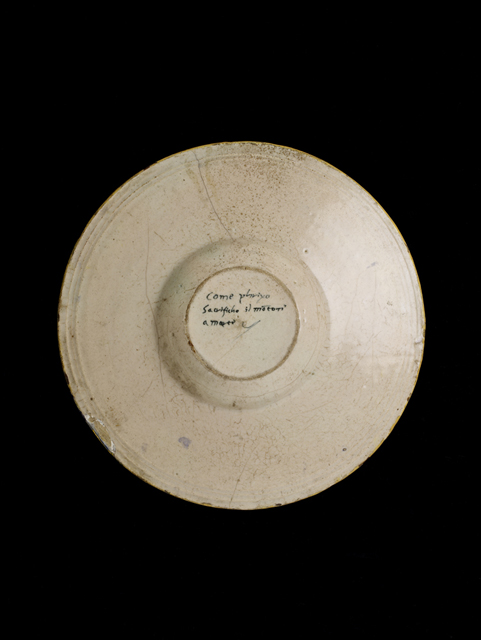Browse Collection
26 of 236

Plate with the Story of Phrixus
Avelli Francesco Xanto
Urbino, probably, c. 1530
26.9cm (diameter)
tin-glazed earthenware (maiolica)
Inscribed on the reverse, Come Phrixo Sacrificho il môton’ a marte (how Phrixus sacrificed the ram to Mars). Following the inscription are two strokes of the brush resembling a y (see Plate with Diana and Actaeon, with a shield of arms). The dish depicts scenes from a Classical myth variously interpreted by Apollodorus, Hyginus and Ovid. Phrixus and Helle, children of the Boeotian King Athamas, were requisitioned for sacrifice to purge the country of famine. They were saved by their dead mother Nephele (“the cloud”) who engineered their airborne escape on the Golden Ram but, passing the strait between Europe and Asia, Helle fell from the ram and was drowned (the Hellespont was supposed to have taken its name from her). Arriving in Colchis, Phrixus sacrificed the ram in gratitude for his escape and gave the Golden Fleece to Aietes, king of the neighbouring country, who nailed it to an oak. Nephele then set an effigy of the ram in the heavens where it continues to shine as a constellation. Of the Classical authors mentioned, Hyginus specifies Mars as the recipient of the sacrifice; Ovid does not mention who it was sacrificed to, while in Apollodorus Phrixus offers up the ram to Zeus, the God of escape.
For the painter, see Plate, Diana and Actaeon, with a shield of arms [LI192.1]. This is a characteristic example of Xanto's early work, probably made around 1526-8, in a period before he is first documented in Urbino (in 1530); it is not certain where he was working at this time but possible locations include Urbino, Rimini, Castel Durante, Faenza, Ferrara, and Gubbio.
No print source has been traced for this composition.
In the Descriptive Catalogue of a small collection of Italian Maiolica in the possession of Henry J. Pfungst (privately printed 1890) no. 27 was a plate with the same subject described as “in the manner of Fra Xanto”; it is not clear whether this is the present plate.
Lent from the Barlow Collection. LI206.17

Click to hide image
Other Images

Click to hide image

|